
NPS / Serena Wurmser Many Zion visitors like to stay for sunset to take photos of cliffs glowing vivid orange in the late day sun. Then, as the last sunlight fades from the sky, a steady stream of cars file out of the park toward homes, hotels, and other destinations. But for those few who stay later or spend the night nearby, an entirely different and memorable Zion experience awaits: the dark night sky, filled with thousands of stars, above the jagged silhouette of cliffs.
Zion is a great place to connect with the night sky, whether you are an avid astrophotographer or this will be your first view of the Milky Way. As an International Dark Sky Park, Zion protects our incredible dark skies for present and future generations by not degrading the night with artificial light. This means that after sunset, the park is very dark. Be prepared! 
NPS photo Plan Ahead and PrepareBefore getting to Zion, prepare for your stargazing experience. Check the Moon phase.When the Moon is above the horizon, its light will wash out fainter features of the night sky, including the Milky Way. Plan to stargaze before the Moon rises or after the Moon sets. Search "Moon rise and set time in Springdale, Utah" online to get Moon rise and set times during your visit. The darkest nights always occur during the week leading up to a New Moon. Pack stargazing essentials.
Have a plan for where to sleep.Camping is only allowed at designated campsites or with some Wilderness permits, so make sure to plan for where you will sleep after enjoying the park’s night sky.
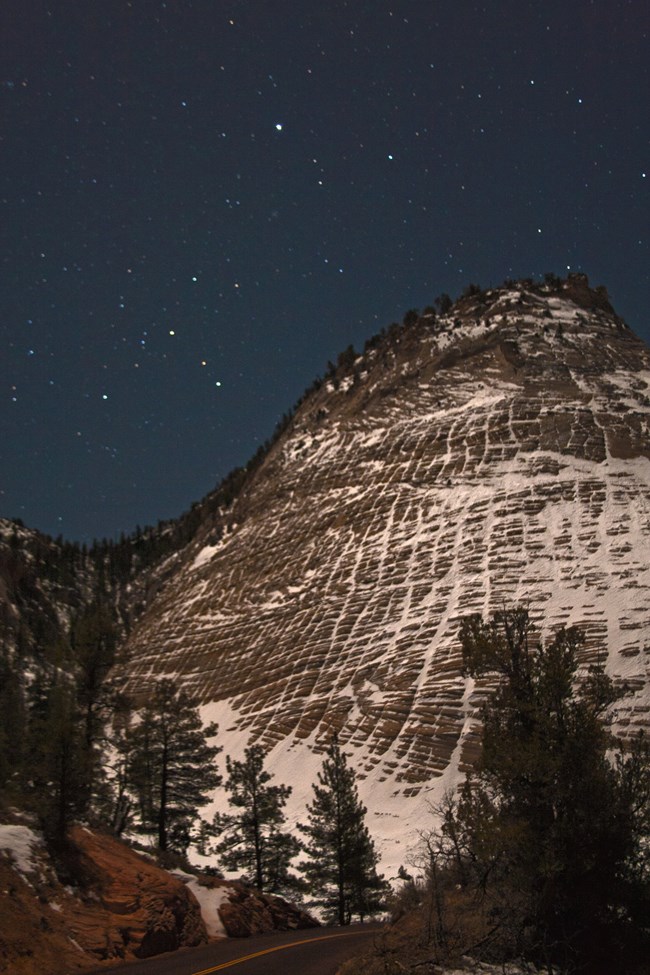
NPS Photo Where Should I Stargaze in Zion?Zion has dark night skies throughout the park. To help with planning, here are some easily accessible night sky viewing areas: Zion Canyon
East Side
Kolob Terrace Road
Kolob Canyons
These locations are all outside of Zion Canyon Scenic Drive and are open to drivers year-round. Destinations on Zion Canyon Scenic Drive are only accessible by shuttle for most of the year. Check the shuttle schedule before you make plans to stargaze along Zion Canyon Scenic Drive. Although you can see the Milky Way from anywhere in Zion, the darkest skies are on the east side of the park and along Kolob Terrace Road. As you travel, please be careful not to hit nocturnal wildlife on roadways. All of these locations have access to restrooms except for Checkerboard Mesa Pullout. If you are planning on bringing a personal telescope, consider setting it up at Checkerboard Mesa Pullout, Lava Point Overlook, or Timber Creek Parking Lot. These three locations have wide views of the sky and flat ground to set-up a telescope. 
NPS photo Once Arriving at Your Selected LocationWait for full darkThe night sky is darkest beginning 1.5 hours after sunset and until 1.5 hours before sunrise. The park is open 24 hours a day, so no need to worry about entering or exiting. Give your eyes time to adjustSit back, relax, and give your eyes at least 20-30 minutes to adjust to the dark. You’ll be amazed how many more stars appear after waiting for 30 minutes! Respect the landscapeDo your part to conserve the park. Don’t go off trail, pack out trash, and reduce your noise so you don’t disturb nocturnal wildlife and other visitors. What will I See in the Night Sky?The park’s night sky and nighttime landscape are constantly changing based on the time of year and the phase of the Moon. 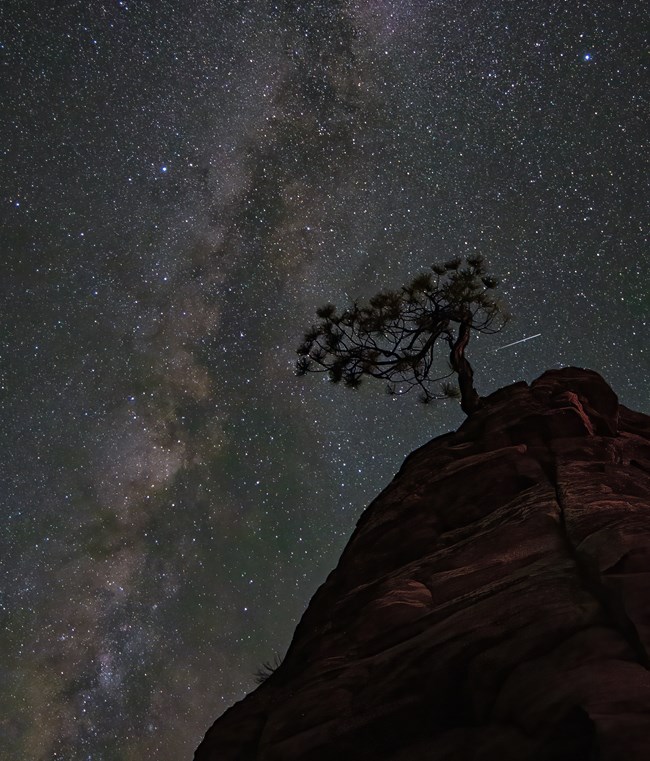
NPS/ Jesse Nelson Time of YearThe night sky changes gradually over the course of the year, such that there are entirely different stars and constellations visible in the summer and winter night sky. Learn more about the different seasons in Zion.
At any time of year, expect to see satellites, meteors (also known as shooting stars), and thousands of stars when you look up at the night sky. The location of planets changes year by year, so search "planet rise and set time in Springdale, Utah" online to see which will be visible during your trip to Zion. 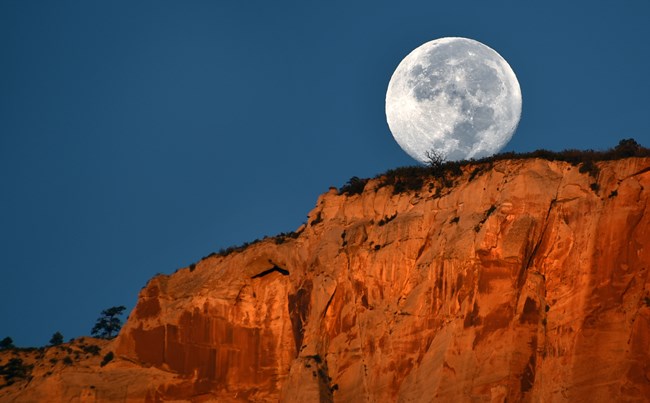
NPS photo Time of MonthThe night sky changes every night based on the phase of the Moon. To determine what the Moon phase will be during your time in Zion, search “Moon rise and set time in Springdale, UT.”
Why Protect Dark Night Skies?The dark night skies that you see while stargazing in Zion are no coincidence. As an International Dark Sky Park, Zion works hard to protect our night skies in a world where fewer and fewer communities have access to a night sky filled with stars. Light pollution—excess light that scatters in the sky—is growing alarmingly fast, and recent studies have found a 9.6% per year annual increase in sky brightness between 2011– 2022 (Kyba et al 2023). Greater than 80% of Americans can no longer see the Milky Way from their backyard.
Humans are not the only creatures impacted by a brighter night sky. Nocturnal animals and insects rely on darkness to hunt or hide. Circadian rhythms of many plants and animals are negatively affected by light pollution. Amid a nighttime landscape illuminated by light pollution, Zion and other national parks are some of the few places left in the country with dark night skies. Although light pollution may seem grim, it is hopeful too, because it disappears instantly once lights are turned off. Here in Zion, we reduce our light footprint by turning out lights when not in use, using outdoor lights only where necessary, shielding outdoor lighting so that it points downward, and using warm color light bulbs such as amber or red. These are all actions you can do at home as well. By working to reduce your light footprint and educating your neighbors about responsible outdoor lighting, you can take the park’s night skies home with you. Observando las Estrellas en Zion Podrá disfrutar de cielos nocturnos oscuros en todo Zion. Mientras observa las estrellas, permanezca en los senderos y en las zonas de estacionamiento, recoja su basura y reduzca el ruido. El parque no cierra por la noche, pero algunas zonas pueden no ser accesibles durante todo el año.
Zion National Park protege los cielos oscuros utilizando luz artificial sólo cuando y donde es necesario. Esto significa que después del atardecer, el parque está muy oscuro. ¡Esté preparado!
Revise la fase lunar.
Lleve lo esencial para observar las estrellas.
Espere a que oscurezca por completo.
Dele tiempo a sus ojos para que se adapten.
Los cielos nocturnos oscuros que se ven al observar las estrellas aquí no son una coincidencia. Como Parque Internacional de Cielo Oscuro, Zion trabaja duro para proteger nuestros cielos nocturnos.
Los cielos nocturnos oscuros son cada vez menos comunes. Más del 80% de estadounidenses ya no pueden ver la Vía Láctea desde sus casas. Reducir la contaminación por luces en el parque permite disfrutar de un cielo nocturno oscuro y protege el hábitat de plantas y animales nocturnos. Zion comparte los horarios de los programas de astronomía actuales y las condiciones del cielo nocturno en los centros de visitantes y en línea.
Want to Learn More About Dark Night Skies?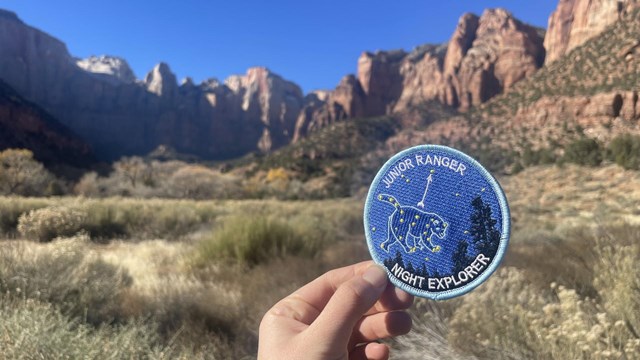
Become a Junior Ranger Night Explorer
Suitable for any age! 
Visit other International Dark Sky Parks
See what night sky sites may be close to you! 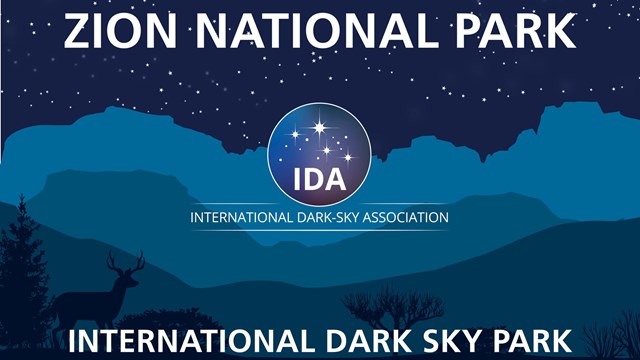
Lighting Projects in Zion
Read about what Zion is doing to protect our dark night skies. 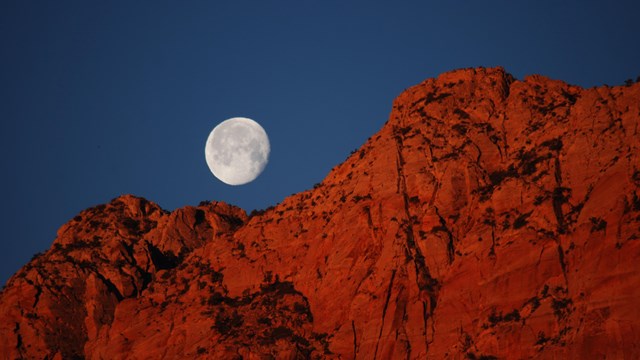
Learn about the Night Sky in the NPS
Explore the work that the NPS is doing to protect and preserve dark skies.
Return to the Things To Do page.
|
Last updated: July 11, 2024
